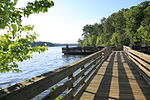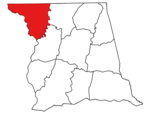Hotel Troy
Buildings and structures in Montgomery County, North CarolinaCommercial buildings completed in 1909Commercial buildings on the National Register of Historic Places in North CarolinaNational Register of Historic Places in Montgomery County, North CarolinaNeoclassical architecture in North Carolina ... and 1 more
Piedmont Triad region, North Carolina Registered Historic Place stubs

Hotel Troy is a historic commercial building located in Troy, Montgomery County, North Carolina. It was built in 1908–1909, and is a three-story, seven bay by eight bay, brick building, rising above a full basement with Classical Revival style design elements. The front facade features cast iron pilasters, columns with foliated capitals and cornices. Originally built for multi-purpose use including a sanitorium, in 1925, rooms in the upper stories were modified for use as hotel rooms and baths. The hotel became a rooming house in the 1950s and finally closed in 1970.It was added to the National Register of Historic Places in 2006.
Excerpt from the Wikipedia article Hotel Troy (License: CC BY-SA 3.0, Authors, Images).Hotel Troy
Smitherman Street,
Geographical coordinates (GPS) Address Nearby Places Show on map
Geographical coordinates (GPS)
| Latitude | Longitude |
|---|---|
| N 35.3625 ° | E -79.895555555556 ° |
Address
Smitherman Street 249
27371
North Carolina, United States
Open on Google Maps





